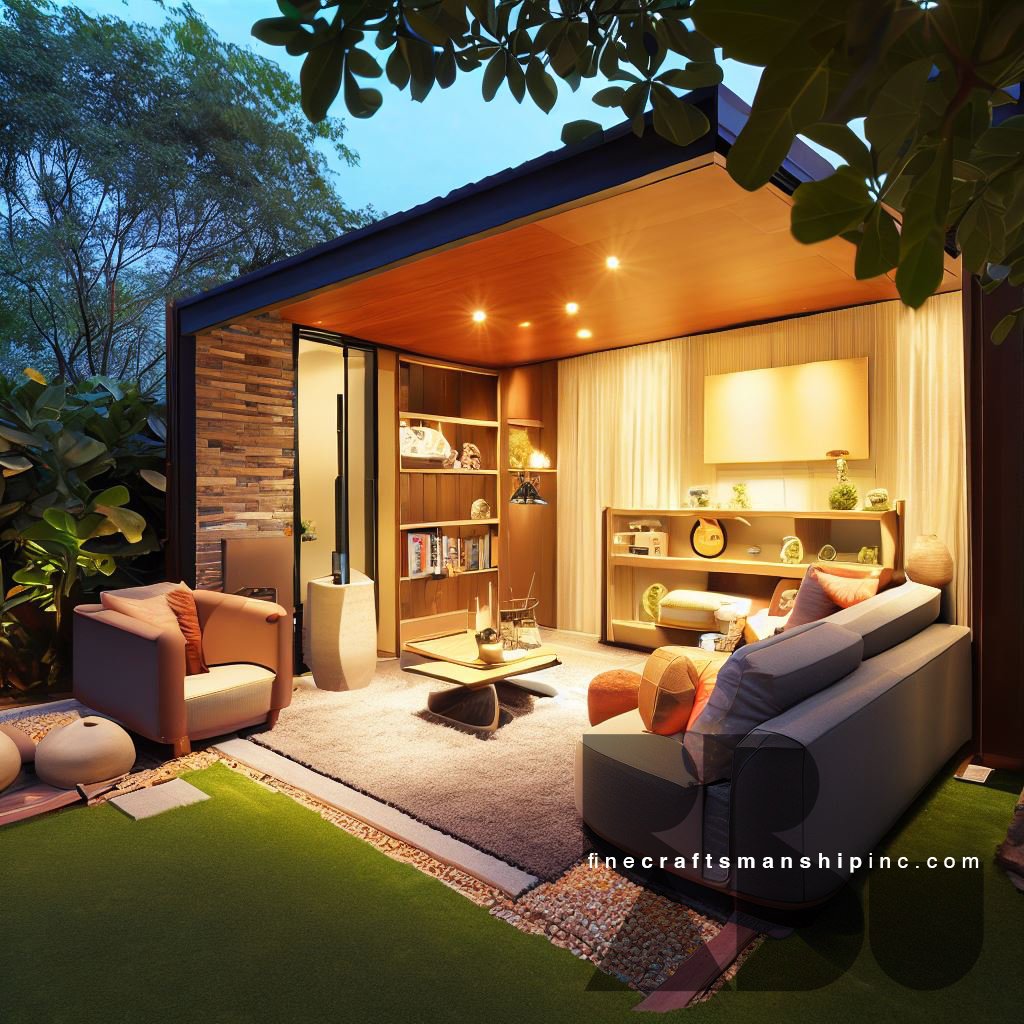6 Things to Know Before Building a Backyard Living Space
Before considering adding a Recreation Room ADU, also known as an Accessory Dwelling Unit, to your property, take a moment to think about the legal, design, and financial implications.
Recreation Rooms or Accessory Dwelling Units, which are separate living units within a single family home or on shared land, are currently very popular.
Numerous cities and counties in at least 35 states, including the District of Columbia, as well as nine states like California, have made changes to their laws to make it easier and more appealing for homeowners to build CONTEMPORARY UNITs.
For many homeowners, CONTEMPORARY UNITs can be an excellent source of rental income or provide living space for adult children or extended family members. They can also serve as a work-from-home area or a retreat for running a home-based business.
Still, there are still enough challenges involved in building one that CONTEMPORARY UNIT author and advocate Kol Peterson said they’re usually undertaken only by homeowners with the motivation, money, knowledge and confidence to see the project through.
For those who are willing and able to build an CONTEMPORARY UNIT, the rewards can be significant.
What is an RR and ADU?
Recreation Room (RR):
Friendly Definition: A recreation room, also known as a rec room, is a special space within a house that is usually used for fun and entertainment activities. This room may have features like a workspace, home theater, office area, and seating arrangements.
Purpose: Recreation rooms are meant for leisure activities, providing a place for relaxation, work, and socializing for the people living in the main house. They are not meant for long-term living or as separate living quarters.
Legal Regulations: The construction or use of recreation rooms must follow local building codes and zoning regulations. These rules usually focus on safety, structural integrity, and limits on occupancy. They may include requirements for things like windows for emergency exits, electrical systems, and fire safety.
Accessory Dwelling Unit (ADU):
Friendly Definition: An Accessory Dwelling Unit (ADU) is a separate residential unit located on the same property as the main house. It is designed to be a self-contained living space, typically having a bedroom, kitchen, bathroom, and living area.
Purpose: ADUs are created to offer additional housing options on a property. They can be used to accommodate family members, generate rental income, or host guests. ADUs are designed to meet the long-term housing needs of individuals or families.
Legal Regulations: The construction and use of ADUs are subject to a complex set of local rules, including zoning ordinances, building codes, and land use regulations. These regulations vary by location but are usually more detailed and strict compared to those for recreation rooms. They cover aspects such as the size of the ADU, setback requirements, parking regulations, and rules about owner occupancy.
We often hear ADUs referred to by other names, such as in-law apartments, granny flats, casitas, or backyard cottages. ADUs were more common before World War II and are now seen as a more affordable housing option. This is because they can be built without the need to purchase land, which is usually the most expensive component of housing prices, especially in costly coastal cities.
"ADUs are still a unique type of housing," according to Peterson, who is an expert on the subject and teaches and writes a comprehensive blog about it. He has also authored a book called "Backdoor Revolution: The Definitive Guide to ADU Development" for homeowners considering building one.
Changes in state and local laws could make the construction of ADUs faster and streamline the building process.
If you're considering building an ADU or buying a home with the intention of building an ADU for rental income or multi-generational living, here are some important factors to take into account.
Six questions to answer before building an ADU
1. Can I build an ADU on my property?
Before you start sketching layouts and picking paint colors for an ADU, it would be a good idea to check with your city or county department that oversees planning, construction, or zoning. They can provide you with the information on whether you are allowed to build, what you are allowed to build, and where.
Please note that rules regarding ADUs can vary widely across the country and even among cities in the same state. You can find an extensive list of cities and states that have adopted ADU regulations at accessorydwellings.org maintained by Peterson.
If your home falls under the governance of a homeowners association (HOA), don't forget to check their rules as well.
Who can I hire to construct an RR or ADU?
If you're considering building an RR or ADU as a DIY project, it's important to realistically assess your skills and how much you're willing to take on. While it's definitely possible to be your own contractor, it requires knowledge, time, and coordination.
If you're someone who enjoys the challenge and satisfaction of building something from scratch and you're eager to learn what it takes, you're in luck!
Developing land - essentially what you're doing when you build a new structure - involves paying attention to aspects you may not anticipate. This includes obtaining construction permits, connecting utilities, and scheduling work at the appropriate pace.
In most cases, you'll likely need to hire professionals for some or all of the tasks, which may include the following:
Design: An architect and/or engineer to create plans. If you're considering a pre-fabricated home or a kit, it's a good idea to check with your local building department to ensure that the home you're interested in meets local building codes. (Some cities, like Los Angeles, even have pre-approved building plans to choose from.)
Additionally, please keep in mind that at Fine Craftsmanship INC, we are thrilled to offer our professional services and high-quality products.
Construction: A general contractor who can oversee the entire project, or individual contractors for electrical or plumbing work.
Site work: This includes water, power, sewage, and grading, if necessary.
If you're hiring professionals, it's recommended to seek recommendations from people who can vouch for their work. The Federal Trade Commission provides useful tips on what to consider before hiring a contractor.
The increased interest and growth in ADU development has led to the emergence of companies that market themselves as one-stop shops for ADUs. Some of these companies offer their own models to choose from, which could potentially make it more cost-effective than building a custom ADU.
If you decide to go for a pre-fabricated or manufactured home that can be delivered to your property, make sure to check with your city or county building department to ensure that it complies with local building codes.
3. How much does it cost to build an RR or ADU?
As a general guideline, RRs or ADUs are not typically inexpensive. Even without considering the costs of land, the expense of construction - and the available methods of payment - are limited.
The cost will vary depending on the size and type of RR or ADU, as well as the local wages. For instance, in San Jose, California - one of the pricier cities in America - it is estimated that a new, custom-built detached RR or ADU may cost as much as $450,000. Retrofitting an existing attached garage or basement may cost approximately $90,000 to $180,000, depending on the size, existing plumbing, and the design of the space.
If you live in a city that offers "pre-approved" building plans, you may be able to save money on the design. Homeowners can utilize these plans to construct their RR or ADU either for free or for a licensing fee. These plans can be customized to some extent and accelerate the review process since they already meet the city's building code and design guidelines.
According to Peterson, an author and advocate for ADUs in Portland, there are fixed costs in new construction, such as excavation and laying a foundation, that contribute to the high cost of even small ADUs. Due to these fixed costs, some homeowners opt to build the maximum allowable size in their jurisdiction, as adding additional square footage is relatively inexpensive.
For instance, in Portland, Oregon, the average cost to develop a detached 400 square foot ADU in 2019 was approximately $170,000. Doubling the size to 800 square feet only added about $40,000 to the overall cost, according to Peterson.
However, it's worth noting that some cities or counties charge "impact fees" for larger buildings. Therefore, it is advisable to check with your local building department when considering the size of your dwelling.
As Fine Craftsmanship INC, we would be delighted to assist you with any inquiries you may have. Please feel free to fill out the contact e-mail form by clicking on this link.
4. Can I finance an ADU?
Financing can sometimes be the most challenging aspect of the process. That's because many traditional lenders do not offer loans for constructing ADUs. The few that do typically only provide loans for work completed by professional contractors, Peterson mentioned. Additionally, these loans often come with higher interest rates and require mortgage insurance.
"Most people piece together various funding sources to cover the costs," he added. These may include refinancing to access home equity, selling investments, borrowing from friends and family, or using credit cards for some of the expenses.
Here are some options for funding:
Utilizing existing savings
Taking a 401K loan
Considering a cash-out refinance
Exploring a second mortgage
Applying for a Home Equity Line of Credit
Obtaining a construction loan
Applying for a renovation loan
Considering a reverse mortgage
Exploring a ground lease agreement
Seeking private financing
Considering shared appreciation
Exploring a shared equity agreement
Investigating alternative funds available through local government or non-profit organizations
Additionally, as Fine Craftsmanship INC, we are delighted to offer loan opportunities of up to 50% of the total budget. Please do not hesitate to reach out to us for more information.
5. How might I save on the construction cost of an ADU?
Converting an existing space into a separate living unit is likely to be more cost-effective than new construction. Just keep in mind that expenses can add up if you opt for high-end finishes.
Another way to save on costs is to build a dwelling using plans that have already been "pre-approved" by your county or city building department.
Consider buying a pre-built model or kit home as it may offer a more budget-friendly option. However, be sure to factor in all relevant costs, including utility hookups. Some pre-built models only include the structure itself, so you'll need to consider the cost of finishing the interior and installing electrical and plumbing systems.
To save money, you can also use doors, cabinets, flooring, and windows salvaged from other construction or demolition projects. Check your local business listings for nearby salvage businesses.
No matter what you decide, it's important to create an inviting space. For inspiration on designs that make small spaces appear larger, you can check out FINE STORE :)
6. Calculate the Return on Investment (ROI) in your real estate market
In cities with expensive housing, rental income can cover the costs of development within a few years. It can also give homeowners the option to downsize in the future without leaving their home, according to Peterson.
Peterson also mentioned that legally permitted ADUs tend to increase the value of a property. While they may not bring instant wealth, RRs & ADUs can be a great way to build financial stability.
Some localities, like San Mateo, California, have developed RR & ADU calculators to help individuals determine if the rental income in their area will be sufficient to cover monthly expenses. Additionally, there are considerations to keep in mind when becoming a landlord.







